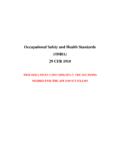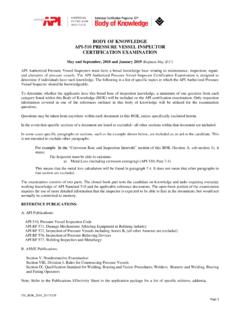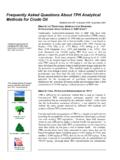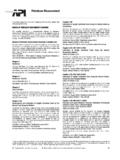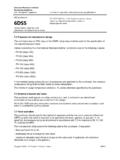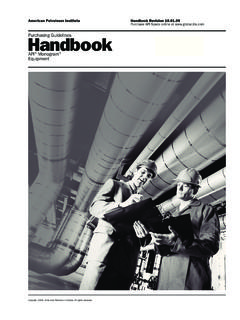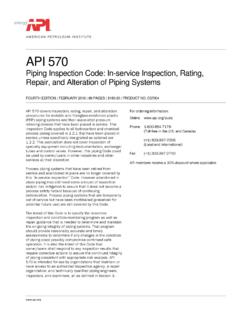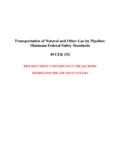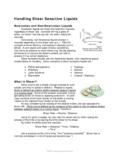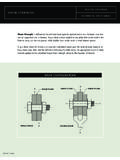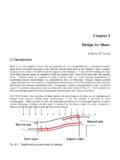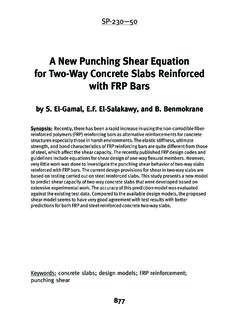Transcription of Trends in Shear Stability of Automotive Engine Oils …
1 1 Trends in Shear Stability of Automotive Engine oils April 19, 2016 Presented by: Dr. Tina Dasbach, Institute of MaterialsCo-Authors: Theodore Selby, Savant GroupDr. Jon Evans, Savant Group2 Agenda Industry Trends Background Viscosity testing Shear Stability results SummaryIndustry Trends Fuel Economy Improved fuel economy and reduced green house gas emissions is a global phenomenon OEM s continue to be challenged by increased fuel economy requirements for their fleets. Lubricants help support new Engine technology and changes that improve fuel economy Lubricants have a role in directly improving fuel economy and fuel economy retention Fuel economy improvement has been shown to be related to the Engine oil viscosity3 Projected European PCMO 2020 Factory Fill RequirementsLube 2016, Issue No.
2 131, February 20165 Source Infineum Lubricating Oil Additives SeminarInfineum FE Studies Studies have been conducted to optimize the lubricant viscosity profile using viscosity modifiers so that, at a fixed high temperature high Shear viscosity at 150 C, the viscosity at lower temperatures is minimized. Frictional losses are reduced at typical operating temperatures, but also Engine protection is provided at peak temperatures. FE VMs delivered an additional FEI credit compared to conventional HSD. ( fuel economy) In our view, selecting a viscosity modifier with a chemistry and architecture that can deliver good Shear Stability while providing a high contribution to kinematic viscosity will be essential as lubricants are formulated to deliver not only excellent wear protection but also fuel efficiency.
3 ( 2015/ Shear Stability up close)67 Chevron Fuel Economy Studies Conducted Engine studies to measure fuel economy improvement for different viscosity grades and gradient conditions (flat roads vs. hilly terrain). Key conclusions: The SAE 10W-30 and 5W-30 Engine lubricants were found to provide more fuel economy potential than SAE 5W-40, 10W-40, or 15W-40 lubricants for the over-the-road heavy duty diesel engines. Conducted HTHS studies to measure the viscosity loss of SAE 10W-30 oils after extended Shear using the Kurt Orbahntest. Useful tool to compare the performance of the viscosity index improvers specifically looking at the ability to retain viscosity after Mischler AEO Market Manager, GOMA Symposium 10/20158 Covitch et al. examined the KO method to assess the effects of polymeric VMs on permanent Shear loss.
4 Bench tests as well as a taxi-cab fleet run with SAE 5W-30 oils and a variety of VMs. In the study, the rate of change of kinematic and HTHS viscosity with time, as well as low temperature cranking and pumping viscosity changes were found to be characteristic of particular VM chemistries. Key conclusions: Within a family of VM chemistry, permanent KV and HTHS viscosity loss was proportional to the average molecular weight (MW) of the VM. As MW increases, it was more susceptible to chain scission and MW reduction by mechanical Shear . In the field test, the KV fell early and increased later for all oils except those formulated with VM RI3. The initial viscosity loss is related to mechanical shearing of the VM and subsequent increase is due to accumulation of suspended contaminants/insolubles.
5 VM chemistry does play a role in the viscosity increase phenomenon, although the authors were not sure why. On a % basis, HTHS decreased less than KV as a result of Shear . The most Shear resistant VM chemistry identified was styrene/isoprene. Background(Low-Temperature Rheology of Engine Lubricants Subjected to Mechanical Shear : Viscosity Modifier Effects, M. Covitch, J. Weiss, I. Kreutzer; Lubrication Science 11-4, August 1999).9 Lubricant Shear Stability is essential to ensure lower viscosity oils offer sufficient protection to engines. This applies to both passenger cars as well as heavy duty diesel engines. Viscosity Modifiers (VMs) are used in lubricants to decrease the oil s viscosity dependence on temperature and allow the formulation of multigrade, non-Newtonian oils that meet both the high and low temperature requirements of SAE J300.
6 Two phenomena are associated with their use: Temporary viscosity loss where under high Shear conditions the polymers align with the flow, resulting in viscosity loss until the Shear is reduced. Permanent viscosity loss where the polymers break due to the Shear ; resistance to breakage is a measure of Shear Stability . FISST and the 90 cycle Kurt Orbahn (KO) diesel injector Shear bench tests were designed to simulate PVL with good correlation to field oils and Viscosity Modifiers10 Nature of Multigrade Engine oils at High Shear RatesTightly Coi led polymer Distended CoilVolume of polymer s viscous influenceSurrounding oil Permeating oil Solubilized Shear GradientRotating coil Quiescent coil Coil in flow Solid surface Multigrade Engine oils made from mineral oil base stocks, are solutions of small amounts of very large molecules (called Viscosity Index Improvers) in the much smaller molecules of the mineral oil.
7 The expanded polymer coil is quite flexible and at increasing Shear rates it is progressively deformed and oriented by the viscous grip of the oil molecules. As the coil deforms, its contribution to the viscosity of the oil becomes less. This response is referred to as Temporary Viscosity Loss (TVL) since the viscosity lost returns to its original state when Shear is Another factor affecting the viscosity of multigrade Engine oils is that the polymeric VMs are subject to degradation by repeatedly passing through cavitation zones in the Engine . In this degradation process, the viscous grip of the oil molecules tears any extended polymer apart. This permanently damages the polymer and reduces its viscometric contribution to the lubricant and this response is referred to as Permanent Viscosity Loss (PVL) since the viscosity lost cannot be of Multigrade Engine oils at High Shear Rates12 SAE Viscosity GradeLow Shear Rate KV (mm2/s) 100 C MinLow Shear Rate KV (mm2/s) 100 C MaxHigh- Shear -RateViscosity (mPa s)at 150 < < < < < < (0W-40,5W-40,and10W-40) < (15W-40,20W-40,and 25W-40, and 40 grades) < < J300 Viscosity Grades for Engine Oils13 Information from the Institute of The Institute of Materials (IOM) was formed in 1984.
8 It was formed to provide an unbiased source of information on marketed Engine oils by publishing test data. 650 newoils are collected annually from the world s market place including the Americas, Europe, and Asia Pacific. Over 14,000 Engine oils have been tested over 30 years. It is the world s largest unbiased collection of such data. The IOM Database reveals the availability of well-formulated Engine oils present on the world s markets, as well as those of questionable quality. Of the more than 30 bench tests used by IOM to test each marketed Engine oil, three are presented here to show the variation of viscosity among the oils collected across the Viscosity Loss Profile15 Equipment used Tannas Basic Rotary (TBR) Viscometer Rotational, dynamic viscosity measurement Shear rate of 200 sec-1 An alternative to kinematic viscosity Measurements made at 100 C and 150 C Samples include fresh and degraded oils FISST 20 passViscosityMeasurements Conducted Under High Temperature, Low Shear Conditions16051015202530 Number of OilsReview of oils Exhibiting Viscosity Increase Behavior at Low Viscosity (cSt)High Temp, Low Shear (cP)2013 5W-30 oils - Viscosity Increase with ShearHTLS VIS AT 100 C (cP)HTLS VIS AT 100 CAFTER Shear (cP)KV AT 100 C (cSt)
9 KV AT 100 C AFTER20 PASS Shear (cSt) Viscosity (cSt)High Temp, Low Shear (cP)2014 5W-30 oils - Viscosity Increase with ShearHTLS VIS AT 100 C (cP)HTLS VIS AT 100 CAFTER Shear (cP)KV AT 100 C (cSt)KV AT 100 C AFTER20 PASS Shear (cSt) Eu10 Eu11 Eu12 Eu13 Eu14 Eu15 Eu16 Eu17 Eu18 Eu19 Ap1 Ap2 Am1 Am2 Am3 Kinematic Viscosity (cSt)High Temp, Low Shear (cP)2015 5W-30 oils - Viscosity Increase with ShearHTLS VIS AT 100 C (cP)HTLS VIS AT 100 CAFTER Shear (cP)KV AT 100 C (cSt)KV AT 100 C AFTER20 PASS Shear (cSt) (cP)Oils2015: 5W-30 oils - HTLS at 100 C and 150 CHTLS VIS AT 100 C (cP)HTLS VIS AT 100 CAFTER Shear (cP)HTLS VIS AT 150 C (cP)HTLS VIS AT 150 C AFTERSHEAR (cP)21 Key Conclusions The low Shear results on several 5W-30 oils revealed some interesting behavior.
10 The sheared or degraded oil had higher viscosity results than the fresh oil at 100 C. Both the dynamic viscosity and the kinematic viscosity results showed the same trend. This behavior of viscosity increase with Shear was observed primarily on 5W-30 oils , and primarily those purchased in Europe. This trend has been growing over the last several years and is spreading to the other regions of the world. Interestingly, the increased viscosity results were not observed with the dynamic low Shear viscosity measurements at 150 C. Based on the performance of the oils , the stay-in-grade requirements appear to an important criteria for the formulators (particularly the 5W-30 oils in Europe).22 Future Trends Work is ongoing with viscosity modifiers for lubricant compositions that enable them to meet the SAE J300 standards while providing compositions that exhibit improved fuel economy, low temperature properties, and gelation-free behavior.
